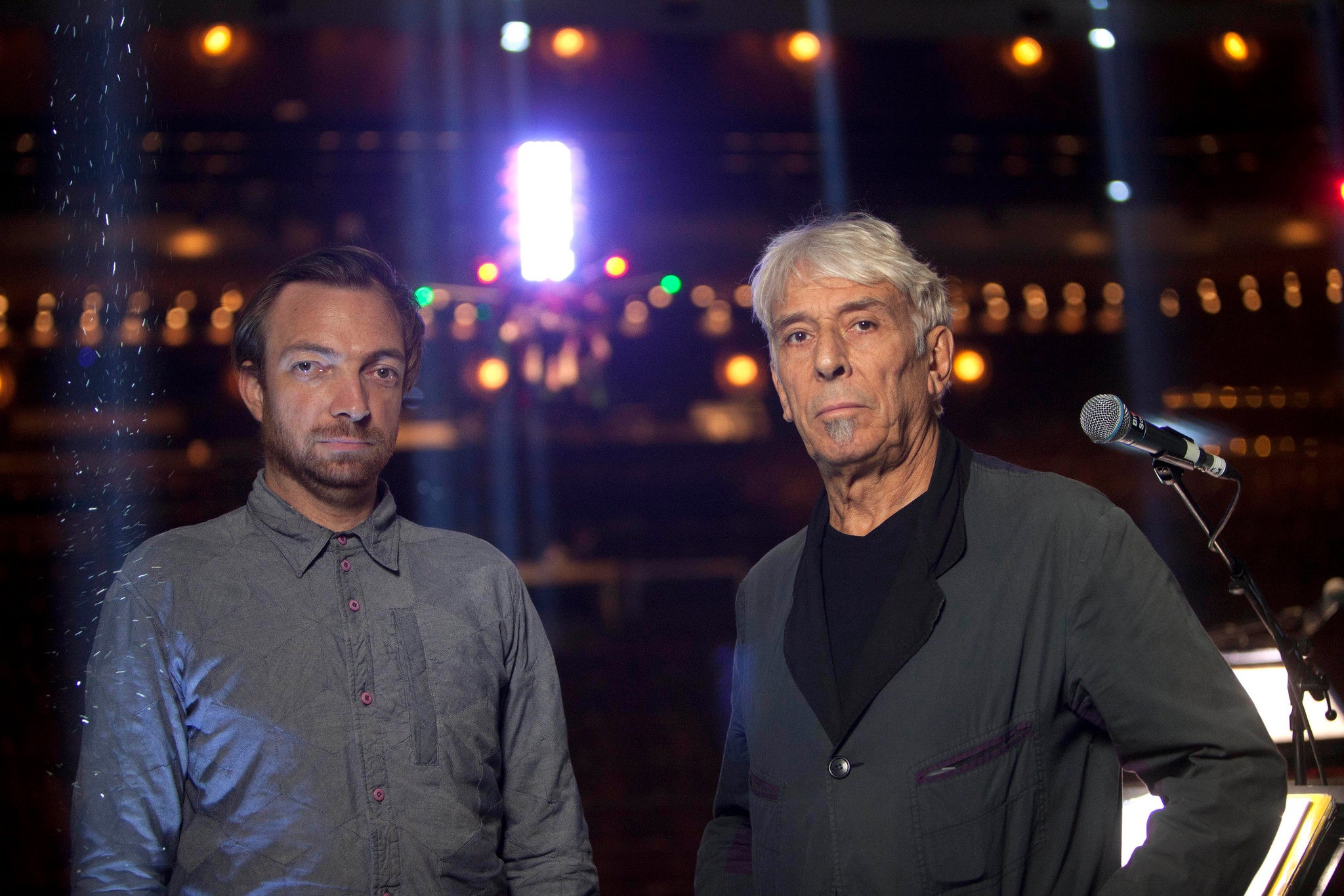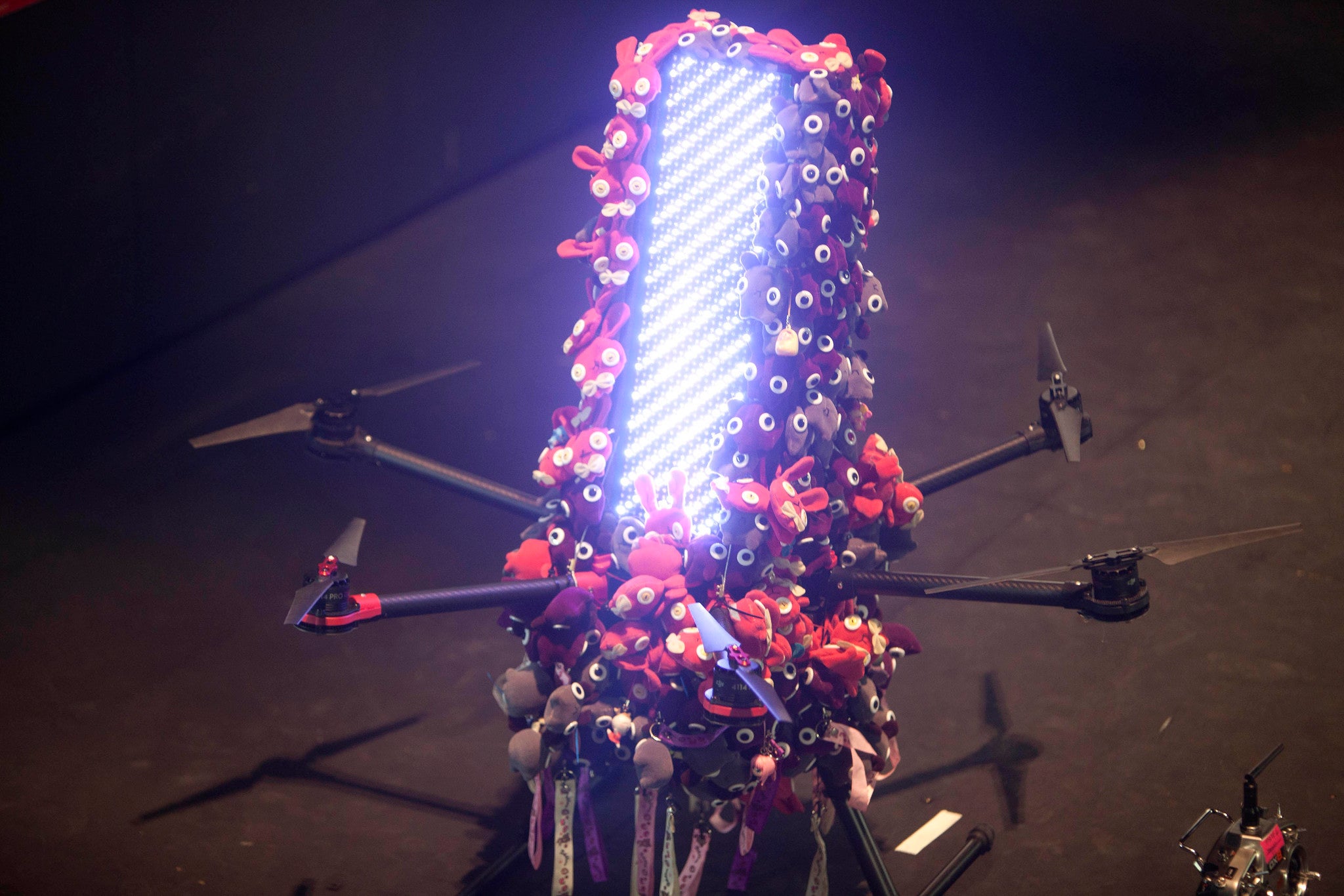John Cale & Liam Young at the Barbican: drones meet drones to sound out the hum of civilization
Velvet Underground founding member John Cale and 'speculative architect' Liam Young took over the Barbican for two nights of havoc. <b>James Vincent</b> met them both to talk about turning drones into art

Your support helps us to tell the story
From reproductive rights to climate change to Big Tech, The Independent is on the ground when the story is developing. Whether it's investigating the financials of Elon Musk's pro-Trump PAC or producing our latest documentary, 'The A Word', which shines a light on the American women fighting for reproductive rights, we know how important it is to parse out the facts from the messaging.
At such a critical moment in US history, we need reporters on the ground. Your donation allows us to keep sending journalists to speak to both sides of the story.
The Independent is trusted by Americans across the entire political spectrum. And unlike many other quality news outlets, we choose not to lock Americans out of our reporting and analysis with paywalls. We believe quality journalism should be available to everyone, paid for by those who can afford it.
Your support makes all the difference.John Cale is no stranger to drones – it almost goes without saying. The 72-year-old former viola prodigy, John Cage protégé and founding member of the Velvet Underground has spent his life tinkering with hypnotic, hallucinatory sounds of one kind or another, early experiments matching the harmonics of refrigerator motors, sifting out the frequencies of modern life (“60Hz is the hum of electricity,” Cale deadpans. “The drone of civilization.”) But it’s only in his most recent project that he’s moved on to the thing itself. The actual drones. Flying ones.
“They have this mesmerising quality which encompasses all of your fears and your fascination with flight,” explains Cale the morning after the final performance of LOOP>>60HZ, his collaboration with designer and “speculative architect” Liam Young - the purveyor of the drones (flying) that accompany Cale’s drones (musical). “And you have hopes in there too,” he adds. “Characters – the drones – which you give roles to.”
Character is something the drones in Cale and Young’s show certainly strive for. Unlike the fixed-wing, military-industrial machines that terrorise the Middle East, Young’s hobbyist quadcopters come in a range of shapes and colours. Some look intestinal, draped in spools of plastic tubing; others are feathered and spiky. My favourite looks like a chubby crescent moon covered in disco ball mirrors that floats serenely through the theatre’s spotlights splashing colour on to the audience.
Young, seated next to Cale, says the intention was to “confound people’s expectations” about drones. “We could’ve made these costumes that were really aerodynamic and efficient,” he explains, the pair of them a little put out that I’d interrupted their post-show analysis and facing me arms akimbo. “But the idea was to make things that had no right to fly – to make things that were utterly unreal, uncanny - surreal as objects.”
The drones certainly fascinated the audience at the Barbican, where Loop was staged as part of the centre’s Digital Revolution series. When the craft first took to the air, rising gently out of the orchestra pit (where else would you put them?) heads craned instinctively in fascination and delight, hairdos buffeted by the downdraft of powerful motors as the drones hovered above, separated from the seated spectators by only a thin net. (Later, I asked if the health and safety people had been amenable to the show; “No, no,” intones Cale dismally. “No, they’re never happy.”)
However, while the flight of drones is certainly exotic to begin with, in the constrained spaces of a theatre there’s only so much movement allowed. A song starts, the drones come out; the song ends, the drones go back. Sometimes they emerge in formation, sometimes one by one. They might swing a little in the air like stoned bees or circle patiently, but after a while it starts to feel a little like a catwalk: it’s striking certainly, but for the uninitiated it not clear exactly what we’re supposed to be looking out for.

No matter. Attention doesn’t have far to wander when Cale’s on stage, coaxing trance beats and feedback from a keyboard and skeletonised viola. And when, during December Rains, a drone rises just a few seconds before the song begins, it feels like the musicians are tuning their instruments to the whirr and buzz of the machine and everything slides over everything else. Did he play with the drones himself? “No, I really had my hands full playing with real people,” (the band? the audience?) before Young adds: “I didn’t get on the guitar either.” The pair laugh a little.
I ask if they’d been happy with the oddly partitioned performance – the drones almost like a sideshow to the music – but they reply that they were content to keep the two sides separate, with Cale explaining that the intention was to create the right environment for what he calls a private response; something “based on serendipity” that “you don’t have any control over” and that belongs entirely to the individual. He wrinkles his face in disgust for a second: “All this surveillance and bullshit.”
Young adds that it was to draw out these same spontaneous, human responses that he dropped any computerised control for the drones. “It wouldn’t have worked if it was just a tech fest and we just had these bare, skeletal drones running around on these hardcore tracking rigs,” he explains. “We’ve seen it before but also it’s not open enough for people to start to fall in love with the character or give it a name, or hate one, or have a crush on another. It needed to have a sense of humanity.” Instead he went for individual pilots, four of them standing at the back of the pit where the percussion might have been, eyes locked on their airborne wards.
Enjoy unlimited access to 100 million ad-free songs and podcasts with Amazon Music
Sign up now for a 4 month free trial (3 months for non-Prime members)
Enjoy unlimited access to 100 million ad-free songs and podcasts with Amazon Music
Sign up now for a 4 month free trial (3 months for non-Prime members)
But are costumes and unscheduled flight paths the way to elicit the sort of response Young and Cale were after? Curator Paul Wombell has described drones as a “metaphor for technology extending human vision” - physical representations of the internet’s capacity to project self from one end of the world to the other – and Young says he wants to remind people that they’re not “autonomous, mindless systems”: if one drops a bomb in the middle of a desert somewhere it’s only because a human told it to. Unfortunately, this sort of message is of lost when we can sefe the operators squinting in concentration, and when the drones themselves look like they just flew through a fancy dress box. There's a human element, sure, but they’re mainly just fun – no threat and not much more than toys.
There’s no doubt that drones are a ripe subject for this sort of performance art, and that Cale and Young are adding to the conversation, but when it comes to the performance, it’s not surprising that the drones (flying) are outclassed by the drones (musical). Cale’s music has been brewing for decades and his performance is as potent as they come, from the blissed-out echoes of Half Past France (“We’re so far away / floating in this space) to the septic thrill of Sister Ray. “This is not a rock and roll show, this is an installation,” he warns me sternly. The guy who hollered ‘you rock John Cale’ in between numbers would beg to differ.
Whatever the interpretation it’s clear that the pair haven’t finished entangling drones and drones together. They talk enthusiastically about future collaborations as Young expands on the difficulty of adapting his craft to flying indoors, the barometric sensors of the aircraft thrown into disarray by the theatre seating and the heat of the house lights. “The irony is that these inanimate machines have more complexities [on stage] than a human does,” he says, while Cale – a pioneer with both computers and motors – nods in agreement. Like the drone technology Cale and Young are playing with, it might be that they have still much more to develop and evolve. “Just to have two weeks sitting in a space,” says Young wistfully. “There’s so much left on the table to do. That’s what’s exciting – and we’re just at the edge of what it could be.”
LOOP>>60HZ : Transmissions From The Drone Orchestra was staged at The Barbican and co-commissioned with The Space as part of their Digital Revolution series
Join our commenting forum
Join thought-provoking conversations, follow other Independent readers and see their replies
Comments